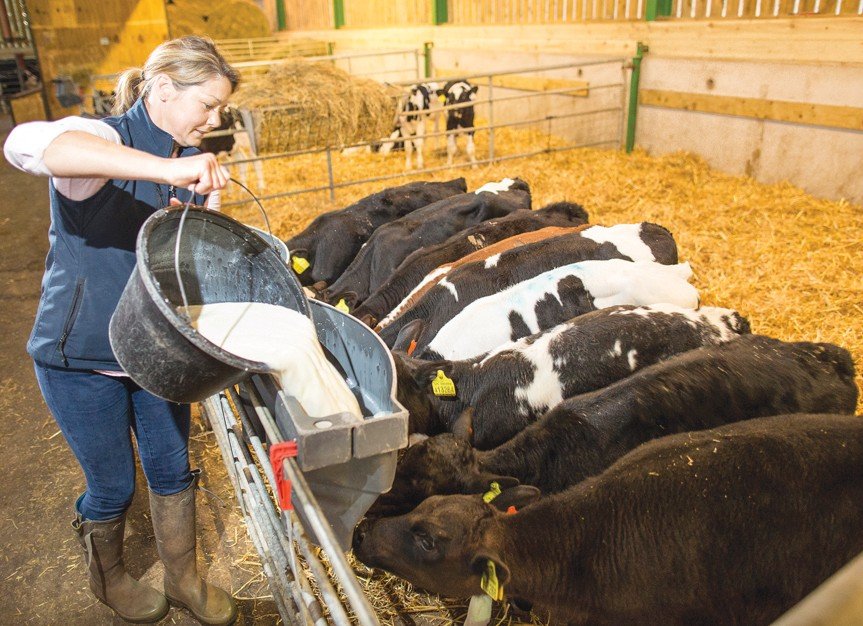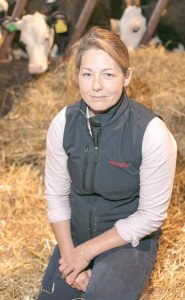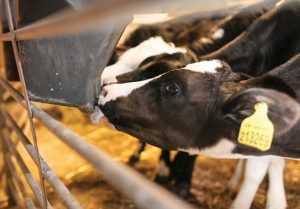
Posted 9.11.17
Three years ago, calf-rearer Lisa Bebbington saw an opportunity to set herself up with her own unit specifically focused on rearing heifer calves through the first 4 months of life – a critical early growth phase.
When a county council farm – Stone Farm, near Langport in Somerset – was put up for sale, Lisa acquired what was effectively a greenfield site. Here, she has overseen the design and construction of a purpose-built calf shed and started her business.
Dairy heifer calves are picked up from the dairy farm once a week and reared until 4 months of age, before being returned there. Rearing is charged on a per calf per day basis. Lisa supplies milk powder, pellets and straw. The farmer pays for vaccines, and for worming and fly tagging when calves are turned out.
Shed design
 Lisa did her own research for the design of the new calf shed, which included visiting farms and getting advice from her vet Oliver Tilling of Shepton Vets.
Lisa did her own research for the design of the new calf shed, which included visiting farms and getting advice from her vet Oliver Tilling of Shepton Vets.
The building has been designed to hold up to 100 ‘baby’ calves. It is 120 x 40ft, and has a 22° pitched roof and vented ridge. For the walls, concrete panels prevent draughts and are easy to steam-clean, and Yorkshire boarding, above calf height, aids ventilation.
Lisa explains: “The heat from the calves is not enough to drive circulation of air, and so ventilation is further improved with two overhead air tubes and fans. This brings fresh air in from outside, and holes in the tubes drop the air just above the calves’ noses. So they don’t feel any draughts.”
Calf pens are sited down either side of the shed. The floor is concreted, and designed to slope from the back of the pens to the front. Excess fluids drain into a central channel.
Management
When calves arrive at 7-10 days of age, they are put into groups of seven or eight per pen. Pneumonia could be a risk, despite the good ventilation. Lisa explains, “My vet carried out tests on cows at the source farm as well as cattle already here at Stone Farm, to see what bacteria and viruses were present. To protect the young calves, we vaccinate for PI3 and RSV at 2 and 4 weeks of age.”
The calves are bedded up every other day with straw and pens are cleaned out every three weeks.
Lisa dehorns the young calves as early as possible using the battery-operated Horn-Up device. She anaesthetises them first, and afterwards administers pain relief using the NSAID Metacam.
 Feeding
Feeding
Buckets of water are available from the start, and are refreshed twice a day. Calves also receive an 18% CP starter pellet ad lib, from day one.
Milk replacer – a 36% protein skim milk powder – is fed at a concentration of 150g/litre. Lisa explains, “I use a kitchen thermometer to ensure it is mixed at 45°C to break down the fats, and then add cold water to cool it down to 38°C for feeding.”
Calves are started off on 2.5 litres twice daily. This rises to a maximum of 6 litres, twice daily, by seven weeks of age. They are then cut back to a 1 litre night feed. At around 9 weeks of age, once they are eating 2kg/day of feed, they are weaned.
Milk is dispensed to the calves via Milk Bar compartment feeders. When the calves arrive into a pen, each feeder is fitted with new Milk Bar teats. The design of the teat slows down the speed of drinking and the similarly aged calves will finish drinking around the same time.
Lisa explains: “Calves stay firmly fixed onto their teat and initially have to suckle hard to get the milk. This prevents them gulping it down too quickly and getting bloat, which has happened with some of the faster-flowing teats.
“Using a feeder is better than a bucket, as calves feed with a natural suckling angle, necks stretched up to the teat.
“The Milk Bar teats also make the calves produce a lot of saliva and afterwards there’s no cross suckling or navel sucking like there is with other teats. They just go and lie down.
“The feeders are strong but light, I find them easy to lift on and off the rail for cleaning. I do this after every feed and steam-clean them once a week. In-between feeds, I flip them upside-down to stop calves sucking the teats.
“The teats are easy to pull out and replace ready for the next batch of calves.”
On weaning, calves are moved out of the shed and out to grass or into hutches where they have free access to haylage and calf rearer nuts.
Lisa weighs the calves when they arrive on the farm and again when they leave aged 4 months. She has been achieving growth rates of between 700-800kg/day.
A new service
This set-up had been proving very successful and Lisa had been contract-rearing 300 dairy calves per year. However earlier this year when a different farm was shutdown with TB, Lisa spotted another opportunity, a niche in the market.
She applied for a licence to become a TB isolation unit, and has taken on rearing the dairy cross calves and black and white bulls. She is rearing them up to 10 months and will then sell them as stirks, once they have two clear TB tests.
When these calves leave, Lisa plans to make her facilities and rearing service available to other TB-stricken farms.
Tags: Milk Bar




